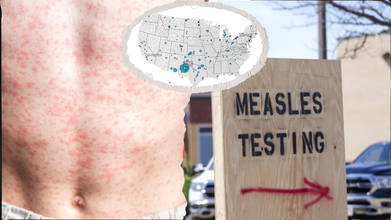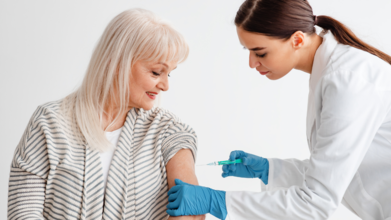- Health Conditions A-Z
- Health & Wellness
- Nutrition
- Fitness
- Health News
- Ayurveda
- Videos
- Medicine A-Z
- Parenting
- Web Stories
World Health Day 2025: History, Theme, Importance, And Significance

Credits: Canva
The World Health Organization (WHO) states that every year on April 7, the World Health Day is observed to draw attention to a specific health topic of concern to people all over the world. The date of 7 April marks the anniversary of the founding of WHO in 1948.
History of World Health Day
This day was first proposed to be celebrated at the First Health Assembly in 1948, and ever since, from 1950, it has been observed. It marks the founding anniversary of the WHO, which a global platform that works on urgent health issues as well as promoting awareness. The WHO also addresses critical health concerns across the world and remains free from political influences. It also uses this day to draw international attention on health priorities.
The WHO notes that when diplomats met to form the United Nations in 1945, one of the things they discussed was setting up a global health organization, this is how WHO's Constitution came into being from April 7, 1948. This is the date that we now celebrate every year as World Health Day.
Theme Of World Health Day
Each year, the WHO announces a specific theme for the World Health Day. This is to spotlight a key area of concern in the health sector. This year, the theme for 2025 is "Healthy Beginnings, Hopeful Futures".
The WHO on its official X handle posted a collaboration with the Ministry of Health and the authorities of Hera to deliver an Integrated Health Program observing this year's theme:
This year's campaign and the theme focus on collaborating with governments and health bodies to invest in impactful initiatives that can reduce preventable deaths. It also aims to improve long-term well-being of mothers and newborn.
The focus points of the theme are:
Helping every woman and baby survive and thrive: The WHO mentions that based on currently published estimates, close to 300,000 women lose their life due to pregnancy or childbirth each year. Whereas 2 billion babies die in their first month of life and 2 million are stillborn. This means roughly 1 preventable death every 7 seconds.
Listening to women and supporting families: WHO mentions that women and families everywhere need high quality care that supports them physically and emotionally, before, during and after birth. Health systems thus must evolve to manage the health issues that impact maternal and newborn health.
"The health of mothers and babies is the foundation of healthy families and communities, helping ensure hopeful futures for us all," notes WHO.
Significance Of World Health Day
For the last five decades, the World Health Day, which celebrates the founding day of WHO has played an important role in highlighting key health issues. It has focused on various health issues including mental health and well-being, maternal and child health, and the growing impact of climate change on global health.
The campaign also facilitates conversations and discourse around health, which can then promote awareness among people. This day therefore serves as a reminder to unite global efforts and direct attention towards building a healthier and safer communities around the world.
After 212 Days, Has US Lost 'Elimination Status' For Measles As Outbreak Hit A Record High Of 1331 Cases

Credits: AP/Johns Hopkins University
Since January 1, 2025, it has been 212 days till July 31, 2025, and in that time, the U.S. has recorded over 1,331 measles cases, surpassing the full-year total for 2019. It’s now officially the worst measles outbreak since the disease was declared “eliminated” in 2000—and one that’s putting that very status at serious risk.
According to Centers for Disease Control and Prevention (CDC) data, corroborated by Johns Hopkins University’s Measles Tracker, between 1,281 and 1,288 confirmed cases were reported as of early July 2025. That number already eclipses 2019’s total of 1,274 cases—and it’s still climbing. The most recent CDC numbers, as of late July, report:
- 1,333 confirmed cases in 40 jurisdictions (states and territories)
- 29 distinct outbreaks, up from just 16 in all of 2024
- Only 12% of current cases are linked to international travel or importation
- 169 hospitalizations and 3 confirmed deaths
To put this in perspective, 2025’s case count is the highest the U.S. has seen in more than three decades, surpassing even the largest outbreaks of the early 1990s.
What Is Meales Elimination and Why It’s Slipping?
Measles was considered “eliminated” in the U.S. in 2000, meaning there was no year-long, uninterrupted local transmission of the virus. Elimination didn’t mean zero cases, but rather, strong containment: sporadic imported cases, caught early, with limited secondary spread. But once local transmission continues for 12 consecutive months, that status is lost—and measles is officially considered endemic once again.
Now, the steep rise in cases, especially those not linked to foreign travel, shows that domestic spread has taken root. Public health experts are increasingly concerned that if these trends continue into 2026, the U.S. may lose its elimination designation—a milestone that was once viewed as permanent.
The loss would be more than symbolic. It would be a failure of the disease control system, the vaccination system, and the health communication system—and would leave millions still at risk.
Why This Matters: Contagion, Hospital Strain, and Global Fallout
Measles is one of the most infectious diseases on the planet, with a basic reproduction number (R₀) ranging from 12 to 18. It indicates that an individual carrier can infect as many as 18 other individuals in a population not vaccinated. It is airborne and remains present in a room for as long as two hours after a sick person has vacated the room.
Although some infections are mild, approximately 1 in 1,000 are fatal, and almost 30% of illnesses result in complications, such as pneumonia, encephalitis, and hearing loss that is permanent. The CDC has also reported extensive hospitalization rates this year, especially in young children, pregnant women, and immunocompromised adults.
Beyond immediate illness, measles causes “immune amnesia,” wiping out existing immunity to other infections. This leaves those who recover from measles at higher risk for other illnesses for months or even years afterward—a threat that is seldom discussed but well-documented in scientific literature.
What’s Fueling the Measles Surge?
The clear driver of the 2025 measles resurgence is declining vaccination rates. The CDC estimates that the national average for two-dose MMR (measles, mumps, rubella) vaccine coverage is now 92.7%—below the 95% threshold needed for herd immunity. But that’s the national average. In some areas, it’s much lower.
Outbreak epicenters have reported MMR coverage as low as 78–82%. For example, certain communities in Texas, Oregon, and Florida are seeing dangerous declines, often influenced by online misinformation, religious or philosophical exemptions, and lack of school-based enforcement of vaccine mandates.
The current administration’s mixed messaging on vaccine safety, dismantling of public health advisory panels, and budget cuts to local health departments have further eroded trust. The CDC and other agencies are grappling with a crisis of credibility, particularly in the wake of pandemic-related misinformation.
Meanwhile, social media platforms remain flooded with conspiracy theories, false claims about vaccine ingredients, and pseudoscientific “natural immunity” rhetoric—further discouraging uptake among already hesitant parents.
What Happens If the US Officially Loses Elimination Status?
If measles persists in circulation for 12 consecutive months, the US will no longer qualify as "elimination"—and this is more than just optics. The implications are real and longstanding. International travel warnings might be revised to incorporate the increased risk of acquiring measles within the U.S., with possible effects on tourism and cross-border travel. School systems could be compelled to reinstate closure policies and enforce more stringent health guidelines during outbreaks, disrupting community and educational routines. In the meantime, premiums and care for health insurance could increase as a result of the added weight of preventable hospitalizations. Worst of all, public fear is likely to escalate, continuing to undermine confidence in vaccines and erode the overall public health framework.
Worse still, vulnerable populations—including infants too young to be vaccinated, immunocompromised individuals, and the elderly—will be constantly at risk. State and local health departments, many of which are understaffed and underfunded, may not have the infrastructure to respond effectively to regular outbreaks.
This scenario would reverse decades of progress, and the U.S. would join a growing list of countries—including the U.K. and parts of Europe—that have lost measles elimination status in recent years due to similar dynamics.
Despite the troubling numbers, public health experts agree on one thing: there’s still time to regain control—but that window is closing fast. To contain the 2025 measles outbreak and prevent a permanent loss of elimination status, several urgent steps are needed. Accelerated vaccination campaigns must be launched, especially in under-immunized schools, districts, and counties where herd immunity has broken down.
At the same time, a coordinated effort to counter vaccine misinformation with clear, science-backed public education is essential. Stronger federal leadership is also critical, with renewed investment in outbreak preparedness, early response infrastructure, and nationwide health messaging. Transparent and timely data sharing will empower local governments and healthcare providers to act swiftly and effectively.
World's First Gonorrhea Vaccine Programme Rolled Out By NHS

(Credit-Canva)
A new vaccine to protect against gonorrhea is now available at sexual health clinics across England. This is a big step in the fight against a serious and fast-spreading sexually transmitted infection (STI). The vaccine is being offered to people who are at the highest risk of getting gonorrhea.
This includes gay and bisexual men who have recently had multiple sexual partners and another bacterial STI within the last year. This new program is expected to protect thousands of people and save the NHS over £7.9 million in the next decade. This is part of the government's new approach to healthcare, which focuses on stopping illnesses before they start, rather than just treating them after.
Who Is Eligible for the Vaccine?
The vaccine being used, called 4CMenB, was originally created to prevent a type of meningitis. However, doctors have found that it also works against gonorrhea. This is great news because gonorrhea cases have been on the rise, reaching a record high of 85,000 in England last year—three times higher than in 2012. By offering this vaccine, health officials hope to prevent up to 100,000 cases of gonorrhea over the next ten years.
This vaccine is also important for another reason: it helps fight the growing problem of antibiotic-resistant strains of the disease. By preventing infections, it reduces the need for antibiotics, which helps keep those medicines effective for everyone. This new program will also take some pressure off busy NHS services.
Increasing Risk Of Gonorrhea
UK Health Security Agency had previously raised concerns with the increase in cases of antibiotic-resistant gonorrhea. While most gonorrhea infections are still easily cured with a common antibiotic called ceftriaxone, some new strains are becoming much harder to treat.
Since 2015, there have been 42 cases of gonorrhea that are resistant to ceftriaxone. What's even more concerning is that 15 of these cases were extensively drug-resistant (XDR), meaning they were also resistant to the second-choice treatments.
These resistant cases are becoming more frequent. In the last year, there have been more resistant cases than in the previous two years combined. Most of these infections are linked to people traveling to and from the Asia-Pacific region, where this type of resistance is more common. While these cases are still rare in England, the increasing number raises the risk of wider spread.
Gonorrhea often has no symptoms, especially in the throat or in the vagina. When there are symptoms, they can include a thick yellow or green discharge, pain during urination, and pain in the lower abdomen. If left untreated, gonorrhea can lead to serious health problems like infertility and pelvic inflammatory disease (PID). The best ways to protect yourself are:
- Use condoms during sex.
- Get tested regularly if you have had unprotected sex with new or casual partners. Testing is free, confidential, and can be done at local sexual health clinics or with a home testing kit.
How Vaccine Impacts Broader Prevention Strategy?
The new gonorrhea vaccine is just one part of a bigger plan to improve public health in England. Public Health Minister Ashley Dalton urges anyone who is eligible to get the vaccine, pointing out that it protects not only themselves but also their sexual partners.
Dr. Sema Mandal, an expert from the UK Health Security Agency, says in the press release that this vaccine is very welcome, especially because of the worrying rise in antibiotic-resistant gonorrhea. She also mentioned that sexual health clinics will continue to offer other important vaccines for mpox, hepatitis A and B, and HPV, giving people a lot of protection against a range of STIs.
Dr. Amanda Doyle, from the NHS adds in and shares that the vaccine rollout a "real step-forward for sexual health." She strongly encouraged everyone who is eligible to get all the recommended vaccines to stay safe and help protect others.
Former Jharkhand CM Shibu Soren Passes Away After a Month on Life Support: What Does It Truly Mean to Be on Life Support?

(Credit-PTI)
At the age of 81, the former Jharkhand chief minister Shibu Soren passed away on Monday 4th August morning. The founder of Jharkhand Mukti Morcha was famously known as "guruji" and had been in the hospital for the past whole month. He had been suffering from a kidney-related ailment as well as a stroke.
His son Jharkhand Chief Minister Hemant Soren confirmed the death in a social media post on X saying: “Respected Guru Dishom has left us all. Today, I have become empty.”
We spoke to Dr. Raghavendra Ramanjulu, Lead Consultant in Aster CMI Hospital to understand the nuances of supported living.
What Does It Mean To Be On Life Support?
Life support is a variety of medical treatments that keep a person alive when their body can't function on its own. These treatments support or replace a failing body part until the body can recover.
Dr. Ramanjulu explains “Doctors suggest life-support for a patient when the body is no longer able to perform essential functions on its own like breathing, maintaining blood pressure, or keeping the heart beating. This often occurs in extreme medical situations such as traumatic injuries, severe infections, heart attacks, strokes, or advanced stages of chronic illness.”
Life support is a serious decision made after doctors have carefully checked the patient's condition and talked with their family. Sometimes it's used for a short time to give the body a chance to heal, while other times it's a bridge to making long-term decisions about care.
It’s important to understand that being on life support doesn't mean a person is dying, but sometimes the body never fully recovers and needs continued support.
When Is Life Support Started Or Stopped Entirely?
Life support is started as soon as a person’s body needs it, but it won't be started if the person has already said no. This can be done verbally, in writing through legal documents, or by family members making the decision for them. Doctors will also not start life support if there is no medical benefit, such as when a treatment would only prolong suffering.
You can be on life support for a long time. Doctors and family members may decide to stop it if there is little chance of a person having a meaningful recovery. It’s legally and ethically okay to end treatments that are no longer helping. It's crucial to remember that death is caused by the underlying illness, not by the decision to stop treatment.
Life-Support Aren’t Permanent or Last Decisions Only
Dr. Ramanjulu described an unforgettable experience about a young man who was put on life support after a severe accident. For days, his condition was very serious, and his family worried he wouldn't make it. The machines kept him alive while the doctors worked nonstop. Slowly, his body began to improve, and he eventually started breathing on his own without the ventilator. Watching him leave the ICU, sitting up and smiling, was a deeply moving moment for everyone. It was a powerful reminder that even in the toughest situations, the human body can surprise us with its will to survive and heal.
What Organs Are Still Active on Life Support?
Dr. Ramanjulu explains that when a person is on life support, some of their organs may still be working on their own, while others are being helped by machines. For example, a ventilator will breathe for the lungs, while the kidneys might still work partially. The brain might also remain active, depending on the injury.
Life support doesn't mean the body has completely stopped working; it just means some vital systems are too weak to function without help. The medical team closely monitors which organs are active, as any sign of natural function offers hope for recovery.
Common Types of Life Support
Life support includes more than just ventilators. It covers any medical procedure that keeps the body running. Here are some of the different types:
Mechanical Ventilation
A machine called a ventilator helps you breathe by pushing air into your lungs through a tube. This is used for short-term problems or long-term if a person has irreversible breathing failure.
ECMO (Extracorporeal Membrane Oxygenation)
This is a more advanced machine that acts as your lungs, adding oxygen and removing carbon dioxide directly from your blood before pumping it back into your body.
CPR (Cardiopulmonary Resuscitation)
CPR is a series of treatments like chest compressions and electric shocks used when a person's heart and breathing stop. It can be life-saving for sudden events but is rarely successful for those with a terminal illness.
AED (Automated External Defibrillator)
A portable device that delivers an electric shock to help a heart with an irregular rhythm return to normal.
Artificial Nutrition and Hydration
This involves giving a person nutrients and fluids through a tube. It can be life-saving until the body heals, but for long-term use with a terminal illness, it may not improve a person’s quality of life.
Kidney Dialysis
A machine that filters waste and extra fluid from the blood when the kidneys are not working. For many, this improves their quality of life, but for others with a terminal condition, the burdens may outweigh the benefits.
© 2024 Bennett, Coleman & Company Limited

